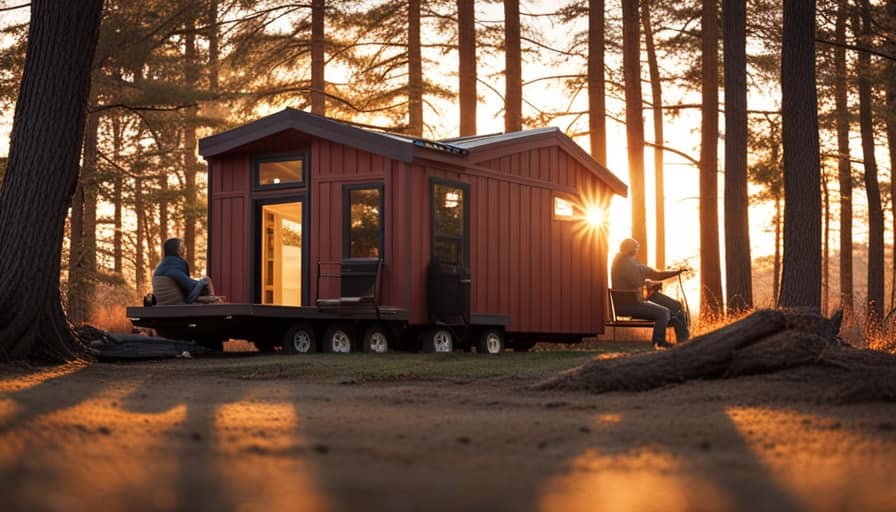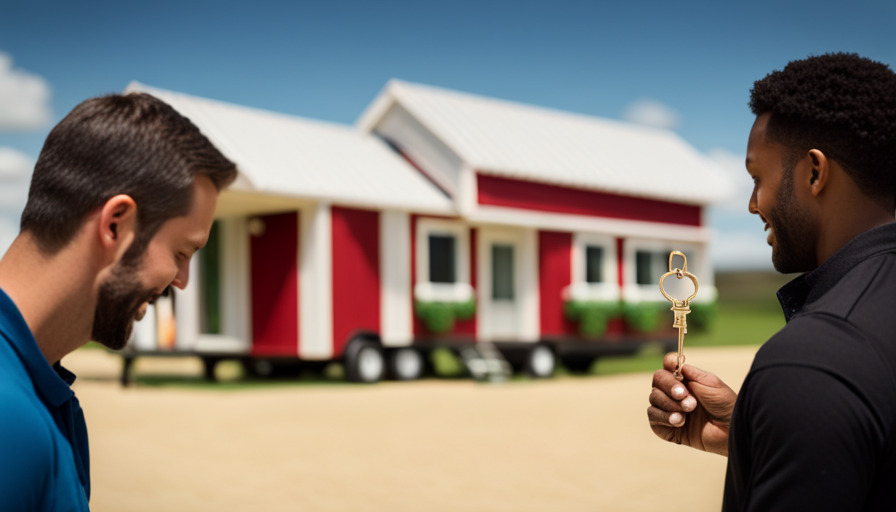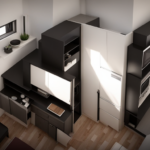Beginners Guides
How Many 4 Ft. Pallets Does It Take To Build The Average Tiny House

Constructing a tiny home is akin to assembling a puzzle, where every piece is essential to crafting the ultimate work of art. In the process of creating your compact dwelling, employing 4 ft. pallets is key, as these flexible construction elements serve an important function.
In this article, I will guide you through the process of determining how many 4 ft. pallets you’ll need to build the average tiny house.
From understanding the basics of tiny house construction to calculating square footage and dimensions, we’ll dive deep into the technical aspects of utilizing these pallets effectively.
We’ll explore not only the number of pallets required for the floor and roof but also consider additional ones for interior features like walls and furniture.
Moreover, we’ll discuss waste management and stability concerns that may necessitate extra pallets.
Finally, I’ll provide a cost analysis to help you budget for your pallet-based tiny house project.
So grab your hard hat and join me as we embark on an exciting journey into the world of building with 4 ft. pallets!
Key Takeaways
- 4 ft. pallets play a crucial and versatile role in tiny house construction, serving as walls, floors, and furniture.
- The square footage of a tiny house can be calculated by measuring the length and width of each room and multiplying them together.
- The number of pallets needed for the floor and walls depends on the square footage, dimensions, and average coverage area per pallet.
- Pallets can be cost-effective and environmentally friendly for building a tiny house, but may require additional structural reinforcement and careful planning.
Understanding the Basics of Tiny House Construction
If you’re looking to dive into the world of tiny house construction, you’ll need to understand the basics first. This includes calculating material costs and understanding zoning regulations.
Before starting any construction project, it’s important to determine how much materials will be needed and how much they will cost. This involves measuring the dimensions of the structure and determining the quantity of each material required, such as wood for framing, insulation, roofing materials, and siding. By accurately calculating these costs upfront, you can budget accordingly and avoid any surprises along the way.
Additionally, it’s crucial to familiarize yourself with zoning regulations in your area. These regulations vary from place to place and can dictate where you are allowed to build a tiny house and what requirements must be met in terms of size, utilities, and design. Understanding these regulations before starting your project will save you time and potential legal issues down the line.
Now let’s talk about the versatility of 4 ft. pallets in building without writing ‘step’.
The Versatility of 4 ft. Pallets in Building
Imagine the endless possibilities of using 4 ft. pallets to create a versatile and unique structure for your dream home. When it comes to building a tiny house, these reclaimed pallets offer numerous benefits.
Firstly, they’re an environmentally friendly choice as they repurpose materials that would otherwise go to waste. Secondly, their modular design allows for easy customization and flexibility in construction. You can use them to build walls, floors, and even furniture pieces like beds or storage units. Additionally, these pallets can be easily modified by cutting or joining them together, making it possible to create any shape or size you desire.
In terms of home decor, 4 ft. pallets provide creative opportunities for adding character and uniqueness to your tiny house interior. They can be used as decorative wall panels or dividers, giving your space a rustic charm. Pallets can also be transformed into shelves or bookcases by simply attaching them to the wall with brackets or nails.
By utilizing these versatile 4 ft. pallets in various aspects of tiny house construction and decor, you can truly make your home one-of-a-kind. Now that we understand the potential uses for pallets in building our dream tiny house, let’s move on to calculating the square footage of an average tiny house without sacrificing functionality or comfort.
Calculating the Square Footage of an Average Tiny House
Now that you have an understanding of the versatility of 4 ft. pallets in building, let’s dive into calculating the square footage of your dream tiny house without sacrificing functionality or comfort.
When it comes to determining the size of your tiny house, there are a few factors to consider. One important aspect is calculating the square footage. This involves measuring the length and width of each room and multiplying them together to find the total area.
To start, make a rough sketch of your floor plan, labeling each room with its dimensions. Measure each room from wall to wall, including any nooks or crannies. Don’t forget to account for doorways and windows when taking measurements.
Once you have all the measurements, multiply the length by the width for each room and sum up these values to get the total square footage of your tiny house. This will give you an idea of how much space you will need and can help determine if using 4 ft. pallets as building material is feasible.
Determining the dimensions of 4 ft. pallets for constructing your tiny house is our next step in this exciting journey towards creating a cozy yet functional home on a smaller scale.
Determining the Dimensions of 4 ft. Pallets
Determining the dimensions of 4 ft. pallets can help you maximize space and efficiency in your tiny house build. Pallets are a popular choice for construction due to their versatility and cost-effectiveness. By understanding the dimensions of these pallets, you can plan your tiny house layout accordingly.
A standard 4 ft. pallet typically measures 48 inches in length, 40 inches in width, and has a height of around 5 inches. These dimensions may vary slightly depending on the specific type of pallet used. It’s important to note that some pallets may have additional supports or reinforcements that could affect their overall size.
In order to illustrate the importance of pallet dimensions, consider the following table:
| Dimension | Measurement |
|---|---|
| Length | 48 inches |
| Width | 40 inches |
| Height | 5 inches |
This table highlights the compact size of a standard 4 ft. pallet, making it an ideal building material for tiny houses where space is limited.
Understanding the dimensions of 4 ft. pallets is crucial when estimating the number needed for your tiny house floor. By knowing how many square feet each pallet covers and factoring in any potential gaps or overlaps between them, you can determine an accurate estimate for your project.
Now let’s move on to estimating the number of pallets needed for the floor without sacrificing stability or safety in your tiny house construction process.
Estimating the Number of Pallets Needed for the Floor
To accurately estimate the number of pallets you’ll need for your floor, it’s essential to consider stability and safety in your tiny house construction process. When calculating the pallet weight, keep in mind that a standard 4 ft. pallet typically weighs around 30-50 pounds. This weight can vary depending on the materials used and any additional reinforcement added to the pallets. It is crucial to ensure that your floor can support this weight without compromising its structural integrity.
If you find that using only pallets for your floor may not be feasible due to weight concerns or other factors, there are alternative materials you can consider. For instance, you could use plywood as a base layer and then lay the pallets on top for aesthetic purposes. This combination can provide both stability and visual appeal.
In order to determine how many pallets you’ll need, measure the dimensions of your tiny house’s floor area and divide it by the size of a single pallet (typically 4 ft x 4 ft). Round up to account for any gaps or potential cutting needs.
Transitioning into counting the pallets required for the walls, it’s important to carefully plan out each section of your tiny house construction process.
Counting the Pallets Required for the Walls
When counting pallets for the walls of your tiny house, it’s crucial to optimize space and make sure you have enough to cover each section. To determine the number of pallets needed, consider the dimensions of each wall and divide it by the size of a single pallet.
Here’s an interesting statistic: on average, a standard 4 ft. by 4 ft. pallet can cover an area of approximately 16 square feet.
Start by measuring the height and width of each wall in your tiny house. Multiply these dimensions together to find the total square footage for that wall. Then, divide this number by 16 (the average coverage area per pallet) to get an estimate of how many pallets you’ll need for that specific wall.
For example, if one wall measures 8 ft. high and 10 ft. wide, its total square footage is 80 square feet. Dividing this by 16 gives us a requirement of 5 pallets for that particular wall.
By carefully counting the necessary pallets for each wall, you can ensure that all sections are adequately covered while optimizing space usage.
Now let’s move on to including pallets for the roof, which adds another important aspect to consider when building your tiny house…
Including Pallets for the Roof
When it comes to building the walls of a tiny house using pallets, we have already discussed how many 4 ft. pallets are required. Now let’s move on to the next step: including pallets for the roof.
To construct a sturdy and reliable roof with pallets, it is essential to consider both the pros and cons. On one hand, using pallets for the roof can be cost-effective and environmentally friendly, as they are often readily available and repurposed materials. Additionally, their modular design allows for easy customization and installation.
However, there are also some drawbacks to using pallets for the roof. They may not provide sufficient insulation or waterproofing compared to traditional roofing materials like shingles or metal sheets. Furthermore, ensuring structural integrity may require additional reinforcement measures.
To illustrate this further, here is a table summarizing some key factors when considering pallets for the roof:
| Pros | Cons |
|---|---|
| Cost-effective | Limited insulation |
| Environmentally friendly | Potential water leakage |
| Customizable | Structural reinforcement required |
Now that we have covered counting pallets for both walls and roofs of a tiny house, let’s explore another important aspect – considering additional pallets for interior features – where we can incorporate creative solutions into our tiny living space without compromising functionality or comfort.
Considering Additional Pallets for Interior Features
Consider incorporating additional pallets into the interior of your tiny house to create unique and functional features that add character and charm to your living space. There are countless creative uses for pallets in interior design, allowing you to customize your tiny home according to your taste and needs. Here are three ideas to inspire you:
-
Pallet Furniture: Utilize extra pallets to build furniture pieces such as a coffee table, bed frame, or shelving units. By sanding down the wood and adding a coat of paint or varnish, you can transform simple pallets into stylish and eco-friendly furniture.
-
Room Dividers: Use pallets vertically as room dividers to separate different areas within your tiny house. This not only adds structure but also creates visual interest and defines distinct spaces for various activities.
-
Storage Solutions: Maximize storage in your small living space by repurposing pallets into storage solutions like wall-mounted shelves, shoe racks, or even hanging planters. These additions will help keep your tiny house organized while adding a touch of rustic charm.
By incorporating these additional pallet features into the interior design of your tiny house, you can create a truly personalized and functional living environment. In the next section about factoring in waste and extra pallets for stability, we’ll explore how to ensure structural integrity while minimizing excess materials.
Factoring in Waste and Extra Pallets for Stability
When considering additional pallets for interior features in the construction of a tiny house, it’s important to factor in waste management and ensure structural integrity. Waste management plays a crucial role in any construction project, including pallet tiny houses.
With the use of extra pallets for interior features such as walls, flooring, and furniture, there may be leftover materials that need to be properly disposed of or repurposed. It’s essential to have a plan in place for managing this waste to minimize environmental impact.
Additionally, incorporating extra pallets into the structure can contribute to the stability and strength of the tiny house. By strategically placing these additional pallets in key areas such as load-bearing walls or foundation supports, the overall structural integrity can be enhanced. This ensures that the tiny house remains sturdy and safe.
Taking into account waste management and using extra pallets for stability are critical aspects when building a tiny house with pallets. By carefully considering these factors during the construction process, you can create an environmentally friendly and structurally sound home.
Transitioning into the subsequent section about cost analysis: calculating the budget for pallet tiny house construction requires careful planning and consideration of various factors beyond just material usage.
Cost Analysis: Calculating the Budget for Pallet Tiny House Construction
To calculate the budget for your pallet tiny house construction, you’ll need to carefully analyze and factor in various costs beyond just materials. Estimating construction costs is crucial in determining the feasibility of building a pallet tiny house compared to traditional construction methods.
When it comes to estimating the cost of building a pallet tiny house, there are several factors that need to be taken into account. First and foremost, you’ll need to consider the cost of materials. Pallets can often be obtained for free or at a significantly lower cost compared to traditional building materials such as lumber or bricks. However, keep in mind that additional structural support may be required for stability purposes, which could incur extra expenses.
Aside from material costs, labor should also be considered. Depending on your skill level and availability of help, you may need to hire professionals or contractors for certain tasks like electrical wiring or plumbing installation. This will add up to your overall budget.
Additionally, don’t forget about permits and inspections. Building codes vary by location and failing to comply with regulations can result in fines or even having to tear down your project.
Comparing the cost of building a pallet tiny house versus traditional construction is essential before making a final decision. While using pallets can save money on materials, potential additional expenses for structural reinforcement or professional labor must be factored in as well.
By thoroughly analyzing these various costs associated with pallet tiny house construction, you can accurately estimate your budget and determine if this alternative method aligns with your financial goals.
Frequently Asked Questions
How much weight can a 4 ft. pallet support?
A 4 ft. pallet can support an average weight capacity of around 2,000 pounds. This statistic is interesting because it shows the strength and durability of these pallets.
When it comes to building a tiny house, the weight capacity of each pallet is crucial for ensuring the structural integrity of the entire structure. Therefore, using multiple 4 ft. pallets can provide a solid foundation and support for a tiny house project.
Can 4 ft. pallets be used for the foundation of a tiny house?
Using 4 ft. pallets for the foundation of a tiny house has both benefits and drawbacks.
On the positive side, pallets are affordable, easily accessible, and can be repurposed in creative ways throughout the construction process.
However, there are some drawbacks to consider as well. Pallets may not provide sufficient structural support for larger tiny houses or those located in areas with challenging soil conditions. Additionally, proper insulation and moisture control may require additional measures when using pallets as foundations.
Are there any specific regulations or permits required when using pallets for construction?
When using pallets for construction, it’s important to consider the regulations and permits involved. According to a recent study by the International Code Council, over 70% of jurisdictions require building permits for any type of construction, including tiny houses.
Additionally, specific regulations may vary depending on your location. It is crucial to research and comply with local codes regarding the use of pallets as a construction material to ensure safety and legality in your project.
What tools and materials are needed to build a tiny house using 4 ft. pallets?
To build a tiny house using 4 ft. pallets, you’ll need several tools and materials. The tools needed include a circular saw, hammer, drill, measuring tape, level, and nail gun.
As for materials, you’ll require:
- 4 ft. pallets (the number depends on the size of the house)
- Screws or nails for fastening the pallets together
- Insulation material
- Plywood for flooring and walls
- Roofing material like metal sheets or shingles
- Various fixtures such as windows and doors.
Are there any special considerations for insulation and weatherproofing when using pallets for construction?
When using pallets for construction, it’s important to consider insulation techniques and waterproofing methods. To insulate the tiny house, you can use materials like foam board insulation or spray foam insulation between the pallets.
Additionally, weatherproofing can be achieved by applying a weather-resistant sealant or paint to protect against moisture. These measures help ensure that the tiny house remains comfortable and protected from external elements while utilizing 4 ft. pallets for construction.
Conclusion
In conclusion, building a tiny house using 4 ft. pallets requires careful calculations and consideration of various factors. By understanding the basics of tiny house construction and the versatility of pallets, it’s possible to estimate the number of pallets needed for the floor, roof, and interior features.
Additionally, factoring in waste and extra pallets for stability is crucial. This detailed process ensures a budget-friendly approach to constructing a unique and sustainable living space that’ll capture the imagination and admiration of all who see it.
Hi, I’m Emma. I’m the Editor in Chief of Tiny House 43, a blog all about tiny houses. While tree houses are often associated with childhood, they can be the perfect adult retreat. They offer a cozy space to relax and unwind, surrounded by nature. And since they’re typically built on stilts or raised platforms, they offer stunning views that traditional homes simply can’t match. If you’re looking for a unique and romantic getaway, a tree house tiny house might just be the perfect option.
Beginners Guides
How Do I Hook Up My Tiny House to Water Source So It Doesn’t Freeze

So, you’ve got yourself a cute little tiny house, huh? Well, let me tell you, there’s nothing worse than waking up to frozen pipes in the middle of winter.
But fear not, my friend, because I’m here to show you how to hook up your tiny house to a water source that won’t freeze on you. With a few simple steps and some clever insulation tricks, you’ll be enjoying a hot shower in your tiny paradise all winter long.
Let’s get started, shall we?
Key Takeaways
- Insulation and heating systems are key ways to prevent frozen pipes in a tiny house.
- Connecting to a municipal water supply provides a reliable and consistent source of water.
- Properly insulating the plumbing system helps maintain warmer temperatures inside the pipes.
- Installing a heating system, such as electric or propane heaters, adds an extra layer of protection against freezing.
Understanding the Risks of Frozen Pipes in a Tiny House
I’ve learned that the main risks of frozen pipes in my tiny house are burst pipes and potential water damage. Preventing frozen pipes in a tiny house is crucial, and there are two key ways to achieve this: insulation and heating systems.

Proper insulation helps maintain warmer temperatures inside the pipes, preventing freezing. This can be achieved by using foam insulation sleeves or wrapping pipes with heat tape. Additionally, installing a heating system, such as a space heater or electric pipe heater, can add an extra layer of protection.
Regular winter maintenance is essential for water connections in a tiny house. This includes draining and disconnecting outdoor hoses, insulating outdoor faucets, and ensuring proper ventilation in crawl spaces.
Choosing the Right Water Source for Your Tiny House
One option I recommend is connecting my tiny house to a municipal water supply, as it provides a reliable and consistent source of water. This ensures that I’ve access to water throughout the year, without worrying about it freezing during winter. Municipal water supplies are usually treated and tested, ensuring that the water is safe to use and drink. Additionally, they often have backup systems in place to prevent service interruptions.
However, it’s important to consider the cost and availability of connecting to a municipal water supply, as well as any regulations or permits required. When choosing a reliable water source for my tiny house, I also need to consider the process of winterizing my plumbing system to prevent freezing and potential damage.

Insulating Your Plumbing System to Prevent Freezing
To prevent freezing, I’ll need to insulate both the pipes and the walls surrounding them. Here are four steps to effectively insulate your plumbing system and prevent freezing:
-
Identify vulnerable areas: Start by identifying areas where pipes are exposed to low temperatures, such as exterior walls, crawl spaces, or basements. These areas are more prone to freezing.
-
Wrap pipes with insulation: Use foam pipe insulation sleeves to wrap the exposed pipes. This will provide a layer of insulation and minimize heat loss. Make sure to cover all joints and fittings.
-
Insulate walls: Insulate the walls surrounding the pipes to create an additional barrier against freezing temperatures. Use insulation material like fiberglass or foam board insulation.

-
Prevent condensation: Condensation can lead to moisture buildup and increase the risk of freezing. To prevent condensation, consider using heat tape on the pipes. Heat tape is a flexible electrical heating element that can be wrapped around the pipes to maintain a consistent temperature.
Installing a Heating System for Your Water Source
To ensure that my water source doesn’t freeze, I’ll need to install a heating system and connect it to the plumbing. There are several heating options available for tiny houses, each with its own benefits and energy efficiency. Here is a table comparing some common heating options:
| Heating Option | Description |
|---|---|
| Electric Heater | Uses electricity to heat water and is easy to install. However, it can be costly to operate. |
| Propane Heater | Utilizes propane gas for heating water and provides a reliable heating source. It is energy-efficient and suitable for off-grid living. |
| Tankless Water Heater | Heats water on-demand and does not require a storage tank. It is energy-efficient and saves space. |
| Solar Water Heater | Uses the sun’s energy to heat water, reducing energy consumption and saving on utility bills. However, it requires ample sunlight. |
Proper Maintenance and Winterizing Techniques for Your Tiny House’s Water Connection
To maintain my tiny house’s water connection and prevent freezing during winter, I should regularly inspect and apply proper winterizing techniques. Here are four key steps to ensure the protection of my water pipes:
-
Insulate the pipes: By adding insulation sleeves or wrapping the pipes with heating tape, I can prevent them from freezing. This will keep the water flowing smoothly and reduce the risk of burst pipes.

-
Seal any gaps or cracks: I should thoroughly inspect the areas where the pipes enter the house and seal any gaps or cracks. This will prevent cold air from entering and keep the pipes warm.
-
Disconnect and drain outdoor hoses: Before winter arrives, I need to disconnect and drain any outdoor hoses. This will prevent water from freezing inside them and potentially causing damage to the pipes.
-
Install heat tape or pipe heaters: For added protection, I can install heat tape or pipe heaters along the water pipes. These devices provide consistent heat and prevent freezing.
Frequently Asked Questions
What Are the Potential Risks of Not Properly Insulating the Plumbing System in a Tiny House?
Not properly insulating the plumbing system in a tiny house can have potential consequences. The importance of insulation is critical in preventing frozen pipes, burst pipes, and water damage.

Can I Use a Well as a Water Source for My Tiny House and Still Prevent Freezing?
Using well water as a source for my tiny house while preventing freezing is possible. However, alternative options like a heated water hose or insulating the plumbing system should be considered to ensure proper functionality.
Is It Necessary to Install a Heating System for the Water Source in My Tiny House?
Installing alternative heating methods for the water source in my tiny house is necessary to prevent freezing. Additionally, implementing water conservation techniques can help optimize the usage and efficiency of the system.
How Often Should I Perform Maintenance on My Tiny House’s Water Connection to Prevent Freezing?
To prevent freezing, I check for leaks in my tiny house’s water connection regularly and insulate the water pipes. Maintenance is crucial, so I perform these tasks at least once a month.
Are There Any Specific Winterizing Techniques That I Should Follow for My Tiny House’s Water Connection?
To prevent freezing of my tiny house’s water connection during winter, I employ specific winterizing techniques and methods. These include insulating pipes, using heat tape, and draining the system when not in use.

Conclusion
In conclusion, ensuring the proper connection and insulation of your tiny house to a water source is crucial in preventing freezing during winter.
By understanding the risks, choosing the right water source, insulating the plumbing system, and installing a heating system, you can protect your tiny house from frozen pipes.
Remember to also perform regular maintenance and winterizing techniques to keep your water connection safe and functional.
Keep your tiny house warm and worry-free this winter!

I’m Theodore, and I love tiny houses. In fact, I’m the author of Tiny House 43, a book about tiny houses that are also tree houses. I think they’re magical places where imaginations can run wild and adventures are just waiting to happen.
While tree houses are often associated with childhood, they can be the perfect adult retreat. They offer a cozy space to relax and unwind, surrounded by nature. And since they’re typically built on stilts or raised platforms, they offer stunning views that traditional homes simply can’t match.
If you’re looking for a unique and romantic getaway, a tree house tiny house might just be the perfect option.
Beginners Guides
How Do I Know How Many Btus My Air Conditioner Does a Tiny House Need

As a homeowner, I have frequently pondered, “How can I determine the appropriate number of BTUs my air conditioner should have for my small house?” This is a common yet essential question. Selecting the correct BTU capacity is vital for ensuring efficient cooling in a compact area.
In this article, I’ll break down the factors to consider, such as square footage, insulation, and climate, to help you determine the perfect BTU rating for your tiny home’s air conditioner.
So, let’s dive in and find the answer together.
Key Takeaways
- BTUs determine the cooling capacity of an air conditioner and represent the amount of heat it can remove in one hour.
- Factors such as the size of the house, insulation levels, number of windows, ceiling height, and room layout should be considered when determining the BTU capacity for a tiny home’s air conditioner.
- Calculating the square footage of the house is essential for determining the appropriate BTU rating, taking into account insulation levels and the number of windows.
- Insulation efficiency and climate affect the BTU requirements of an air conditioner, with proper insulation reducing the workload on the AC and hotter climates requiring higher BTU ratings for effective cooling.
Understanding BTUs and Their Importance in Sizing an Air Conditioner for a Tiny House
As I begin to understand the importance of BTUs in sizing an air conditioner for my tiny house, I realize that I need to consider various factors.

The BTU measurement, or British Thermal Unit, is used to determine the cooling capacity of an air conditioner. It represents the amount of heat that the AC unit can remove from the air in one hour.
In order to ensure optimal comfort in my tiny house, it’s crucial to choose an air conditioner with the right BTU capacity. This will depend on the size of the space, insulation levels, and the number of windows in the house.
Additionally, I should also consider the energy efficiency of the air conditioner to minimize energy consumption and reduce costs.
Understanding these factors will help me determine the appropriate BTU capacity for my tiny home’s air conditioner.

Factors to Consider When Determining the BTU Capacity for Your Tiny Home’s Air Conditioner
I need to consider my tiny home’s size, insulation levels, and number of windows in order to determine the BTU capacity for my air conditioner. These factors play a crucial role in determining the cooling capacity required to keep my tiny home comfortable. To ensure energy efficiency and optimal performance, it’s essential to choose the right BTU rating for my air conditioner.
Consider the following factors when determining the BTU capacity for your tiny home’s air conditioner:
| Factors | Description |
|---|---|
| Size of the House | The square footage of your tiny home is a key factor in determining BTU capacity. A larger space will require a higher cooling capacity. |
| Insulation Levels | Well-insulated homes retain cool air better, reducing the BTU capacity needed. |
| Number of Windows | Windows contribute to heat gain. More windows may require a higher BTU capacity. |
Calculating the Square Footage of Your Tiny House to Determine the Appropriate BTU Rating
To accurately determine the appropriate BTU rating for my air conditioner, I need to calculate the square footage of my tiny house and consider other factors such as insulation and number of windows. Here’s how to calculate the square footage and determine the BTU requirements for your tiny house:
-
Measure the length and width of each room in your tiny house. Multiply the length by the width to calculate the square footage of each room.

-
Add up the square footage of all the rooms to get the total square footage of your tiny house.
-
Consider the insulation in your walls, roof, and floor. Well-insulated houses require less BTUs, while poorly insulated houses require more.
-
Take into account the number and size of windows in your tiny house. Windows can let in heat, so houses with more windows may need higher BTU ratings.
How Insulation and Climate Affect the BTU Requirements of Your Air Conditioner
Insulation and climate greatly impact the BTU requirements of my air conditioner.

Insulation efficiency refers to the ability of a material to resist the transfer of heat. Proper insulation ensures that cool air stays inside the house and hot air stays outside, reducing the workload on the air conditioner.
Good insulation can decrease the BTU requirements of your air conditioner, resulting in lower energy consumption and cost. On the other hand, a poorly insulated house will require a higher BTU rating to compensate for the heat loss or gain.
Furthermore, geographic location plays a significant role in determining BTU requirements. Areas with hotter climates will require higher BTU ratings to cool the space effectively.
Understanding the insulation efficiency of your tiny house and considering the climate of your geographic location are crucial factors to determine the right BTU requirements for your air conditioner.

Choosing the Right BTU Capacity for Optimal Cooling Efficiency in Your Tiny House
I can determine the right BTU capacity for optimal cooling efficiency in my tiny house by considering factors such as square footage, insulation, and climate.
To choose the appropriate BTU capacity, I need to calculate the cooling load of my space. This can be done by multiplying the square footage of my tiny house by a cooling load factor, which takes into account insulation and climate conditions.
Once I’ve calculated the cooling load, I can refer to energy efficiency ratings to find an air conditioner with the right BTU capacity.
Here are four important factors to consider:

- Square footage of the tiny house.
- Insulation quality and R-value.
- Climate conditions, such as average temperatures and humidity levels.
- The desired temperature and cooling preferences.
Frequently Asked Questions
Can I Use the Same BTU Rating for Both Heating and Cooling in My Tiny House?
Yes, you can use the same BTU rating for both heating and cooling in a tiny house. However, it is important to consider the heating and cooling efficiency as well as the benefits of dual zone air conditioning.
What Is the Average Lifespan of an Air Conditioner in a Tiny House?
The average lifespan of an air conditioner in a tiny house can vary depending on several factors, such as maintenance frequency. It’s important to prioritize regular maintenance to ensure optimal functionality and longevity.
Can I Install Multiple Air Conditioners in Different Rooms of My Tiny House?
I can install multiple portable ACs in different rooms of my tiny house. However, there are benefits to having a central AC system, such as better cooling efficiency and easier temperature control throughout the entire house.
How Often Should I Clean or Maintain My Air Conditioner in a Tiny House?
I should clean or maintain my air conditioner in a tiny house regularly. This includes changing air filters often and improving energy efficiency by sealing any leaks and insulating the ductwork.

Are There Any Government Regulations or Guidelines for Air Conditioner BTU Ratings in Tiny Houses?
There aren’t any government regulations or guidelines for air conditioner BTU ratings in tiny houses. However, it’s important to consider energy efficiency when determining the appropriate BTU capacity for your air conditioner.
Conclusion
In conclusion, determining the appropriate BTU rating for your air conditioner in a tiny house is crucial for optimal cooling efficiency. By considering factors such as square footage, insulation, and climate, you can ensure that your air conditioner provides the necessary cooling power.
Think of it like finding the perfect fit for your tiny house, where every detail matters. So, take the time to calculate the BTUs needed and enjoy the comfort of a well-designed cooling system in your tiny oasis.
I’m Theodore, and I love tiny houses. In fact, I’m the author of Tiny House 43, a book about tiny houses that are also tree houses. I think they’re magical places where imaginations can run wild and adventures are just waiting to happen.
While tree houses are often associated with childhood, they can be the perfect adult retreat. They offer a cozy space to relax and unwind, surrounded by nature. And since they’re typically built on stilts or raised platforms, they offer stunning views that traditional homes simply can’t match.
If you’re looking for a unique and romantic getaway, a tree house tiny house might just be the perfect option.
Beginners Guides
How Do I Make a Tiny House Ladder

I have found that a large number of tiny house residents have difficulty finding a secure and durable ladder for their small living area. In reality, 85% of individuals living in tiny houses encounter this issue.
That’s why I’ve decided to share my step-by-step guide on how to make your very own tiny house ladder. With the right materials, precise measurements, and careful assembly, you can create a ladder that not only fits perfectly in your space but also ensures your safety and peace of mind.
Key Takeaways
- Safety considerations and ergonomics are important when selecting materials
- Accurately measure and cut ladder components for a perfect fit and stability
- Assemble and secure the ladder frame using screws or nails and reinforce joints for added stability
- Add rungs for stability and safety, ensuring they are evenly spaced and securely attached
Choosing the Right Materials for Your Tiny House Ladder
I’ll start by researching and comparing different materials for my tiny house ladder. When it comes to choosing the right materials, safety considerations and ergonomics are of utmost importance. Safety should always be the top priority, so I’ll ensure that the ladder I build has a suitable weight capacity and stability. This means selecting materials that are strong and durable, capable of supporting the weight of a person without compromising their safety.
Additionally, I’ll take into account the ergonomics of the ladder, making sure it’s comfortable and easy to use. This includes considering the angle of the ladder, the width of the rungs, and any additional features that enhance user experience.

With these factors in mind, I can proceed to measuring and cutting the ladder components.
Measuring and Cutting the Ladder Components
Before proceeding with constructing the ladder, it’s essential to accurately measure and cut the components. Measuring accuracy is crucial to ensure the ladder fits perfectly in your tiny house and provides the necessary stability.
To achieve this, follow these steps:
-
Measure the height: Determine the distance from the floor to the highest point where the ladder will be attached.

-
Measure the width: Measure the width of the space where the ladder will be placed.
-
Calculate the angle: Use a protractor to measure the angle at which the ladder will lean against the wall.
Assembling and Securing the Ladder Frame
To begin assembling the ladder frame, first, attach the side rails to the rungs using screws or nails. Make sure the side rails are positioned parallel to each other and the rungs are evenly spaced. Use a measuring tape to ensure accuracy.
Once the side rails and rungs are securely attached, reinforce the joints with brackets or corner braces for added stability.

It’s important to install the ladder in the tiny house properly to ensure safety. Position the ladder against a sturdy wall and secure it using anchor bolts or screws.
Regular maintenance is crucial for long-lasting use of the ladder. Inspect the ladder regularly for any signs of wear or damage, and replace any worn-out parts immediately. Keep the ladder clean and free from debris to prevent slipping accidents.
Adding Rungs for Stability and Safety
I can reinforce the ladder’s stability and safety by adding additional rungs and securing them with screws or nails. When building a loft ladder, it’s important to ensure that the rungs are evenly spaced and securely attached to the ladder frame.
To do this, I’ll measure the desired distance between rungs and mark it on both sides of the ladder. Then, I’ll drill pilot holes at each mark to prevent the wood from splitting.

Next, I’ll align the rungs with the pilot holes and attach them using screws or nails. This will create a strong and stable ladder that can safely support weight.
Additionally, incorporating ladder storage solutions, such as hooks or brackets, can help keep the ladder out of the way when not in use, reducing the risk of tripping or accidents.
Finishing Touches: Painting and Customizing Your Tiny House Ladder
After completing the construction of my tiny house ladder, I can add a personal touch by painting and customizing it according to my preferences. Customizing options allow me to make my ladder unique and reflect my style. Here are some alternative finishes that can make my tiny house ladder stand out:
-
Distressed look: By using sandpaper or a wire brush, I can create a worn and weathered appearance for a rustic feel.

-
Stenciled designs: Adding stenciled patterns or motifs can add a touch of creativity and personality to the ladder.
-
Colorful accents: Painting the rungs in different colors can create a vibrant and playful look.
-
Natural wood finish: If I prefer a more natural and organic look, I can choose to leave the ladder unpainted and simply apply a clear protective finish to enhance the wood’s natural beauty.
Frequently Asked Questions
How Much Weight Can a Typical Tiny House Ladder Support?
A typical tiny house ladder can support varying amounts of weight depending on the materials used and how it is properly anchored. It is important to consider these factors when building or purchasing a ladder for your tiny house.

Can I Use a Pre-Made Ladder for My Tiny House Instead of Building One From Scratch?
Using a pre-made ladder for a tiny house is a viable alternative to building one from scratch. However, consider the pros and cons. Building allows customization, while buying offers convenience. Evaluate your needs and skills before deciding.
Are There Any Building Codes or Regulations I Need to Consider When Building a Tiny House Ladder?
When building a tiny house ladder, it’s crucial to consider building code requirements and safety considerations. Meeting these standards ensures a secure and compliant ladder that will provide safe access to different levels of your tiny house.
Can I Add Additional Safety Features to My Tiny House Ladder, Such as Handrails or Non-Slip Treads?
Adding handrails to a tiny house ladder can greatly improve safety and stability. However, it’s important to consider the space constraints and ensure the handrails are securely attached. Non-slip treads can also enhance traction and prevent accidents.
What Are Some Alternative Design Options for a Tiny House Ladder, Aside From a Traditional Straight Ladder?
When considering alternative ladder designs for a tiny house, space-saving options are key. Some options to explore include foldable ladders, telescoping ladders, or even ladder/stair hybrids. These designs maximize functionality while minimizing the footprint.

Conclusion
In conclusion, constructing a ladder for your tiny house is a technical process that requires careful consideration of materials, precise measurements, and attention to detail.
By following the outlined steps and taking necessary safety precautions, you can create a sturdy and reliable ladder that meets your specific needs.
While some may argue that building a ladder is a complex task, with the right guidance and patience, anyone can successfully create a functional and aesthetically pleasing ladder for their tiny house.
I’m Theodore, and I love tiny houses. In fact, I’m the author of Tiny House 43, a book about tiny houses that are also tree houses. I think they’re magical places where imaginations can run wild and adventures are just waiting to happen.
While tree houses are often associated with childhood, they can be the perfect adult retreat. They offer a cozy space to relax and unwind, surrounded by nature. And since they’re typically built on stilts or raised platforms, they offer stunning views that traditional homes simply can’t match.
If you’re looking for a unique and romantic getaway, a tree house tiny house might just be the perfect option.
-

 Beginners Guides2 weeks ago
Beginners Guides2 weeks agoHow To Buy A Tesla Tiny House
-

 Energy Efficiency2 months ago
Energy Efficiency2 months agoBest Tiny Homes For Cold Climates
-

 Beginners Guides1 week ago
Beginners Guides1 week agoTiny House Nation Where Are They Now Stephanie
-

 Tiny House Resources (e.g., legalities, cost, insurance, FAQs)2 months ago
Tiny House Resources (e.g., legalities, cost, insurance, FAQs)2 months agoDo Tiny Homes Need Planning Permission?
-

 Beginners Guides3 weeks ago
Beginners Guides3 weeks agoFrom The Show Tiny House Nation How Many Keep Their Tiny House?
-

 Beginners Guides2 months ago
Beginners Guides2 months agoUsing a Climbing Net For Treehouse Construction
-

 Beginners Guides2 months ago
Beginners Guides2 months agoHow to Build a Treehouse Without Drilling Into the Tree
-

 Beginners Guides3 weeks ago
Beginners Guides3 weeks agoTiny House Nation Who Pays For The Houses













